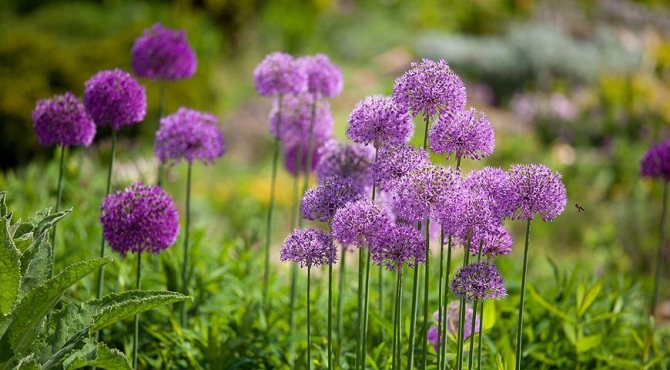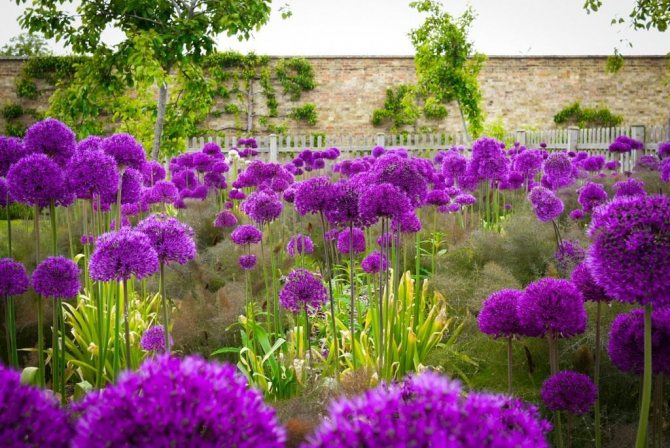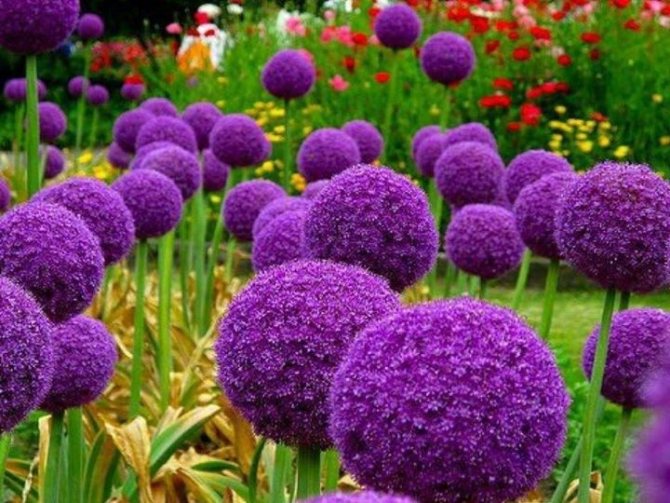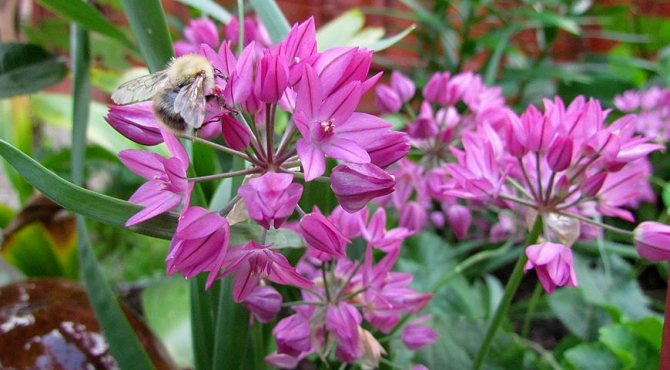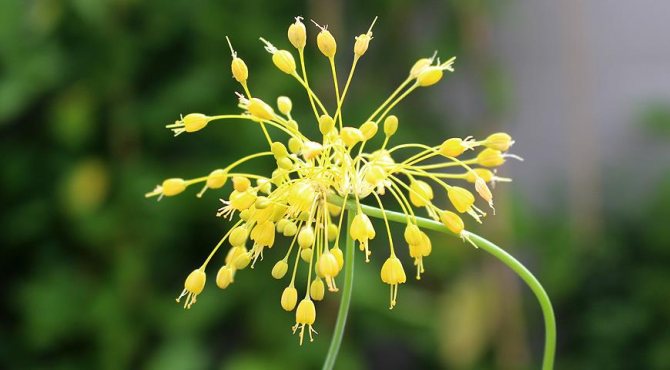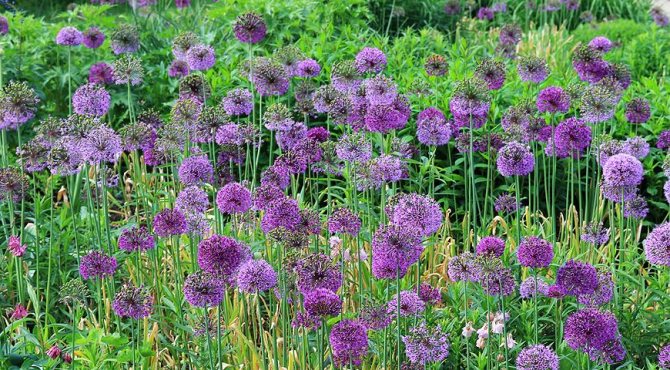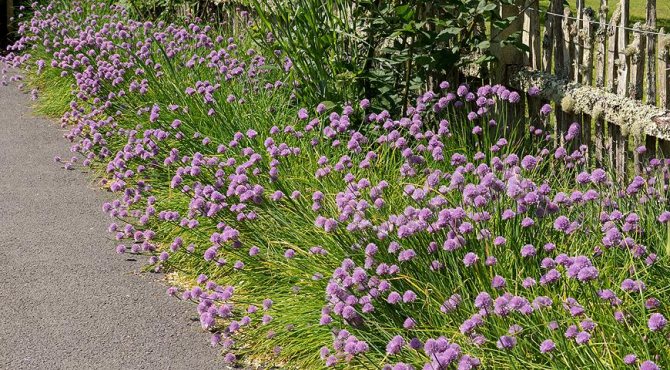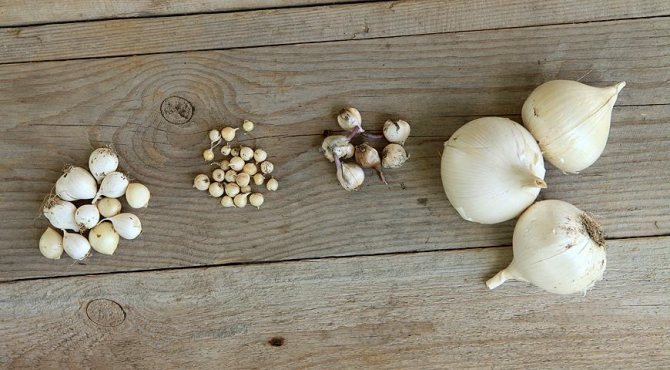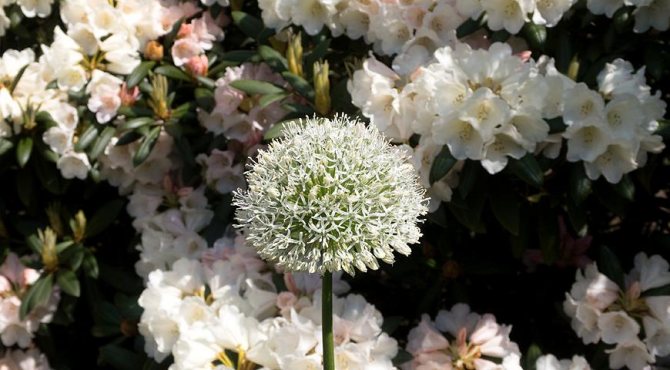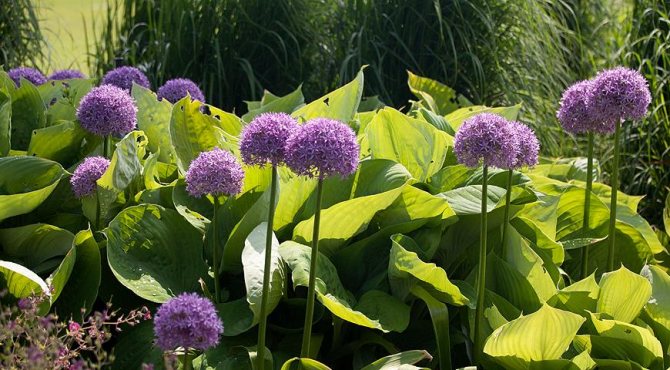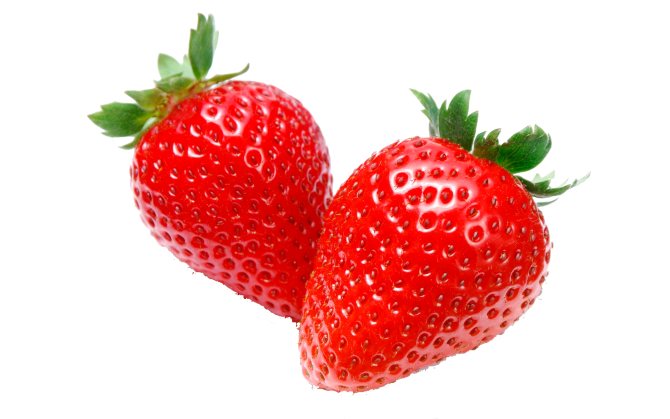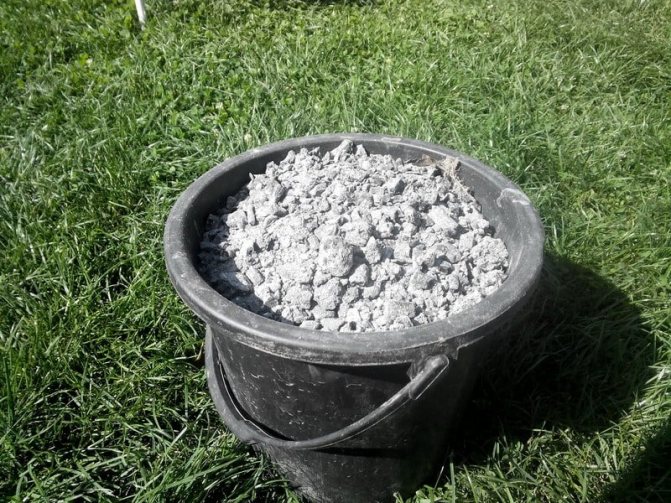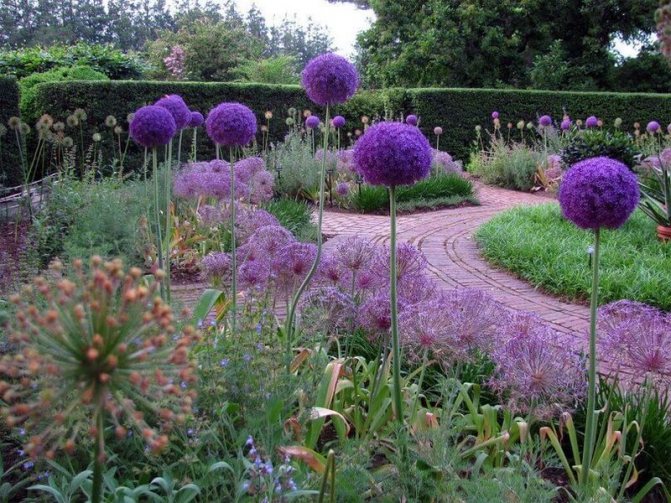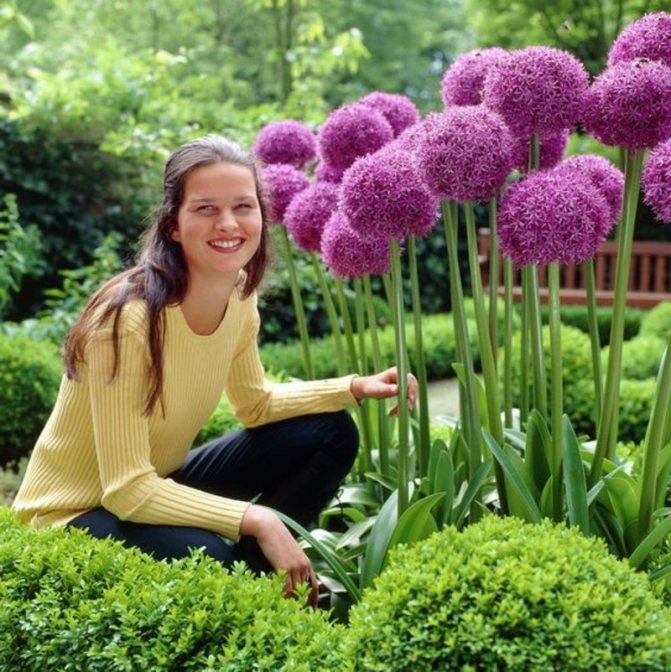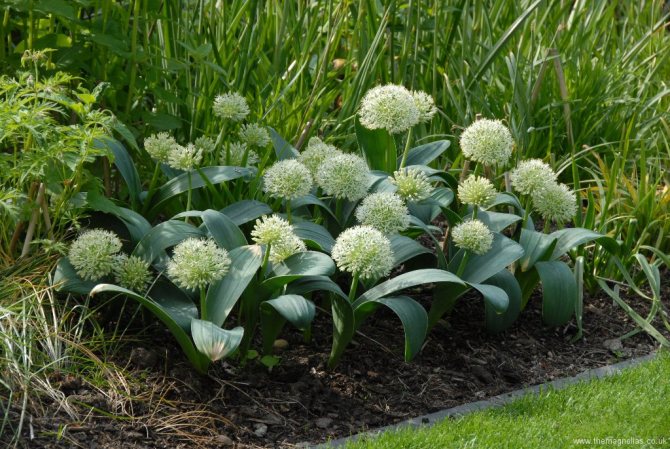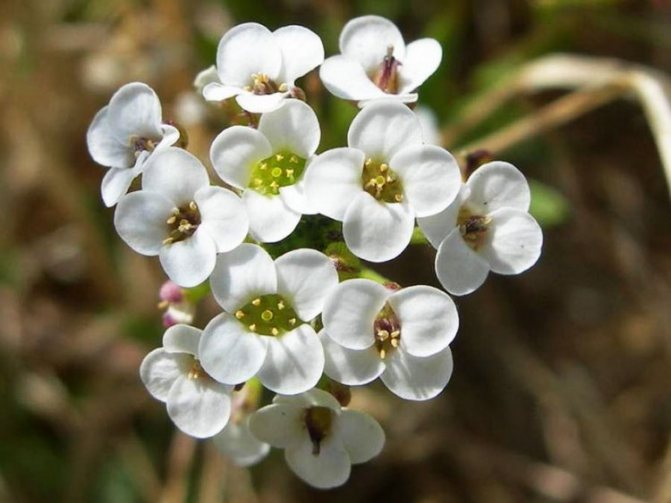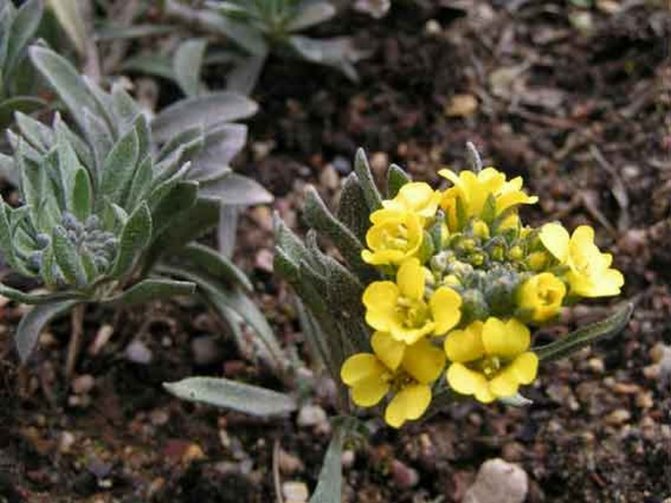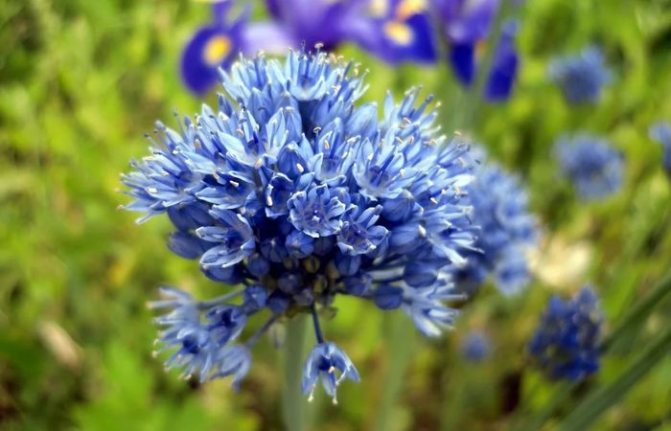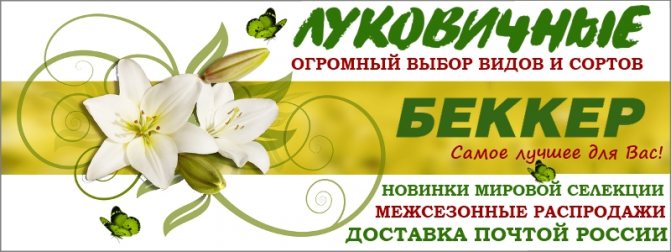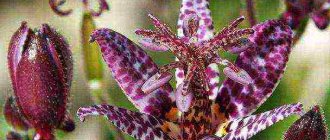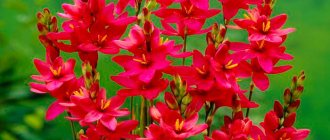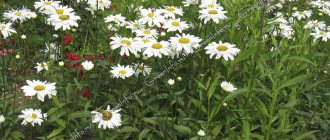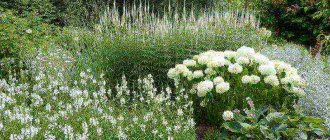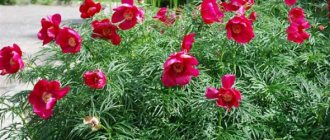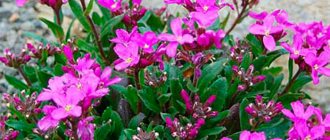Allium (Allium) or ornamental onion is a herbaceous biennial or perennial plant from the Onion subfamily, which has a large bulb. In appearance, this plant of the Amaryllis family is so different from other inhabitants of the flower garden that it is difficult to confuse it.
A high (in some species up to 1 m), swollen stem is crowned with an umbrella-shaped inflorescence of a spherical shape, consisting of many small flowers on long pedicels. In some representatives, the size of the inflorescence can reach 40 cm in diameter. Different varieties will delight with flowering from June to September.
The plant has a characteristic pungent onion smell and taste due to the presence of essential oils, but allium is valued by flower growers for something else. Exotic external data make it possible to use it in rock gardens, rocky gardens, single plantings and flower arrangements.
What is a decorative bow allium, photo and description
Allium belongs to bulbous perennial plants. Unfortunately, this representative of the flora is not widespread enough and is not very popular with domestic flower growers. And very much in vain. Today, botanists have more than seven hundred onions, differing in size, time and duration of flowering, the palette of flower colors and its shape.
The duration of flowering is long, about three weeks, but the inflorescences themselves, if not removed at the end of flowering, also look quite picturesque.
Allium flowers decorate the garden, but they are also suitable for cutting, they can be used in summer bouquets or used as dried flowers.
The plant is attractive and because it does not require a lot of space for growth, it is an excellent honey plant.
From the name itself, it is easy to guess that it is a close relative of the rather common, familiar to us, onions and garlic.
The native land of the plant is Central Asia, it gained popularity in Europe only from the beginning of the nineteenth century.
Botanists from the Imperial Botanical Garden of St. Petersburg contributed to the spread of decorative bulbous crops, who, in fact, collected a collection of the most beautiful representatives of the species and started breeding new varieties.
With the exception of Schubert and Christoph varieties, alliums are resistant to low temperatures, not particularly demanding on soils, and withstand drought well.
For planting bulbs, you should choose well-lit areas, the plant will feel much more comfortable, and therefore the appearance will be more decorative.
It is not required to dig up the bulbs annually; they can grow in the same area for several years.
If desired, allium can even be grown in a regular flower pot.
How can you dilute alium bulbs in your garden?
For such a plant, you can pick up many neighbors. For example, bushes of scarlet roses and roseum will look great in the garden. This combination will reveal all the tenderness of the colors that they possess. A specific aroma will only emphasize the beauty of such an exposition. It is up to everyone to decide how to dilute the allium bulbs when planting decorative plantings in their garden. But it is necessary to take into account the height of the plants and their flowering periods.
Poppy is also perfect for making an allium garden interesting and beautiful.Red poppy inflorescences will be in perfect harmony with any type of bulbs.
cultivation experience
at home ... read
Landing rules
To begin with, it is not so easy to buy ornamental allium onion bulbs, not every garden center will offer you at least a couple of varieties of this plant.
There is a much wider choice in online stores, so in order to save time and money, it is easier to immediately search for sites offering seeds for planting.
It is advisable to plant onions in the fall. As a last resort, resort to spring planting. Autumn planting is carried out in September or early October, when the air and soil temperatures drop.
The depth of the wells for should be about twice the height of the bulbs. The prepared wells are slightly moistened.
On one square. meter, you can plant up to 50 bulbs of large plants or up to hundreds of small ones.
After planting the bulbs, the site is covered with a thick layer of mulch (peat or humus), watered abundantly. The formation and growth of roots continues until the soil temperature drops below +3 C.
By color, all bows can be divided into several categories.
Purple and lilac decorative bows
Giant bow, Aflatun bow, Karatavian bow, Christophe bow, bow bow, cute bow, Schubert bow, Ambassador bow, Gladiator bow, John Dix bow.
Blue decorative bows
Blue onion
White decorative bows
Strange onion, Neapolitan onion, Zebdan onion, black onion, Mount Everest onion, Gracefull Beauty onion, Ivory Queen Karatavian onion.
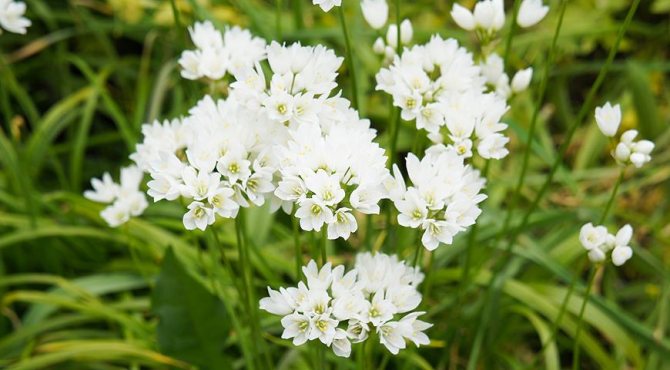

In the photo: Zebdan onion
Yellow decorative bows
Moth onion, yellow onion
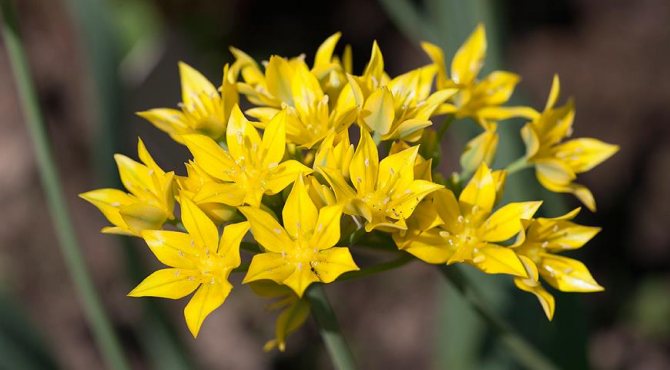

In the photo: Onion Mola is a 15–25 cm tall plant. It blooms in June. The disadvantages include early yellowing of the foliage.
Pink and reddish decorative bows
Sicilian onions, round-headed onions, pretty onions, wilted onions, Ostrovsky's onions, Silver Spring onions, Summer Drummer onions, Forelock onions, Rosy Giant onions
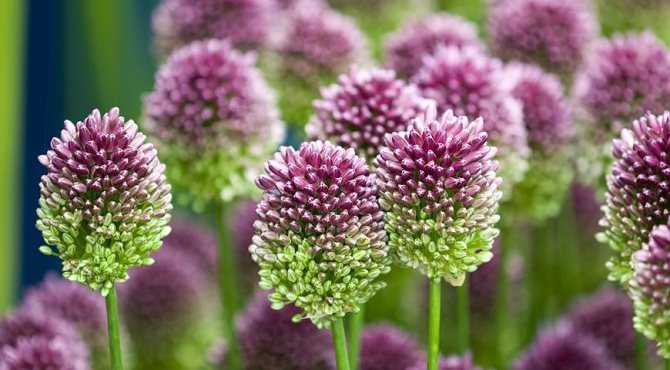

In the photo: Round-headed onion is a beautiful onion, which is usually planted in flower beds with other perennial herbs. As the flowers bloom, the color of the umbrella changes sequentially. About 60 cm high. Stable.
Maroon decorative bows
Dark purple onions, black and purple onions.
Top dressing and watering
Fertilize the soil when digging, before planting the bulbs. Fertilizers can be used both mineral and compost. The next plant feeding is carried out by loosening the soil in spring. When choosing a fertilizer, one must remember that the plant is very sensitive to a lack of potassium.
You can also feed the plants during the budding period.
At the very beginning of autumn, the last top dressing of the season is made: wood ash is added.
Alliums do not need abundant watering, they should be moderate and should be done only if the soil is very dry.
Watch the video about caring for the allium decorative bow:
Subtleties of care
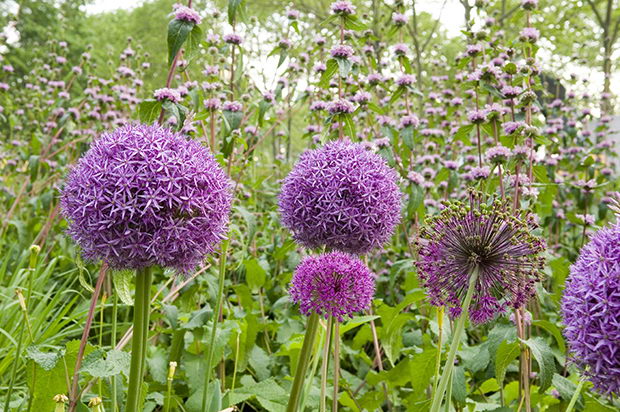

Allium planting in spring photo
The key to excellent growth and flowering will be the observance of the golden mean in watering: it should be constant but moderate. From an excess of moisture, the plant will die, and from a lack - it will stop growing, but it is able to recover. There is a need for annual spring cleaning of the area occupied by allium. Throughout the entire period of growth, constant weeding, loosening of the soil is necessary (especially after heavy rains).
In the spring, you need to fertilize with mineral fertilizers for active budding of the plant. After the end of the flowering period, a fertilizer containing potassium (the simplest and most accessible is wood ash). Allium will favor any specialized fertilizer for garden plants.
Decorative allium onion: is it necessary to dig it out after the end of flowering
Since the plant is an ephemeroid, an annual digging procedure is not necessary.You can plan a transplant in 5-7 years. Onions hibernate in the open field, without shelter.
But you should take into account the weather conditions in a particular area: too rainy and cool autumn can cause the development of putrefactive processes in the bulbs. In such cases, it will be rational to dig up the bulbs, dry them and plant them in the ground.
It is recommended to extract the bulbs from the soil after the leaves have completely wilted. If the second half of summer is dry and warm, then it is better not to touch the bulbs.
Growing conditions
To grow any kind of ornamental onion, it is important to comply with certain conditions:
- loose and neutral soil, the optimum acidity level is 7.0 pH;
- upland - in the lowlands, rainy weather and melting snow lead to stagnant water, which is unacceptable for growing ornamental onions;
- the optimal time for planting early flowering species is autumn, late flowering species - spring from the end of April;
- sunny area - a sufficient amount of color provides a beautiful color of leaves and richer shades during flowering;
- the right neighborhood - you can plant irises, peonies, delphiniums, poppies nearby.
The plot chosen for growing ornamental onions must be dug up to 20-25 cm. For fertile soil, additional fertilizers are optional. If the soil is loamy or sandy loam, the following fertilizers should be applied in an amount per square meter:
- humus or rotted compost - 5-7 liters;
- simple superphosphate - 25-30 g;
- potassium sulfate - 25-30 g, can be replaced with a liter of wood ash.
Allium bloom
Almost all varieties begin to bloom in May, or rather, in the second half of the month. The inflorescences themselves look quite attractive, they can have different sizes and colors. The diameter of the inflorescence of the largest of the decorative bows reaches 20 cm in diameter.
The flowering time for each variety is different, from a couple of weeks to two months. When choosing planting material, it should be borne in mind that the flowering of some varieties, for example, Allium pulchellum, begins in August.
High anzur or mountain bows
Anzura, or mountain bows, Is a group of tall onions native to the mountains of Central Asia, with general characteristics and growing requirements. The Anzurians have a short growing season: spring - early summer; average height 100–150 cm, diameter of inflorescences 6–12 cm. Anzur flowers bloom in late May - early June.
These are large onions, planting density depends on the effect you want in spring, but usually no more than 50 bulbs per m2.
Sometimes some species are self-seeding, young onions bloom in the 2nd to 4th year.
Most popular anzura: giant onion, Aflatun onion, stalked onion, Suvorov's onion, high onion and the highest onion.
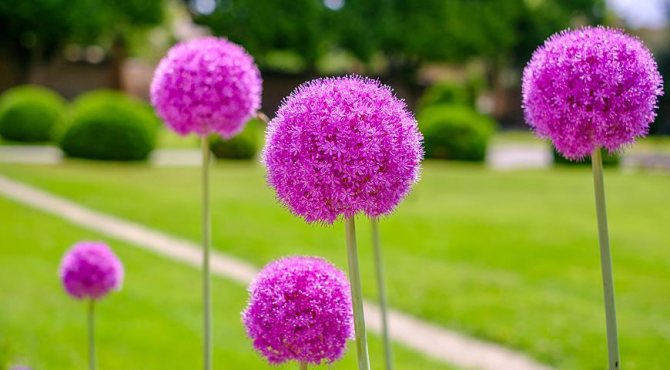

In the photo: Giant bow
Possible reasons for the lack of flowering
Complaints about the lack of onion flowering can be heard very rarely, even novice gardeners can grow a beautifully flowering plant.
However, the cases are different, for example, flowering may be absent:
- with an incorrect landing;
- for the reason that it is too young;
- when landing in a wetland;
- with strong freezing in winter.
It will also not be possible to get abundant flowering with excessive watering.
Content:
- Rock gardens and rocky flower beds
- Bows in flower bed design
- Allaria
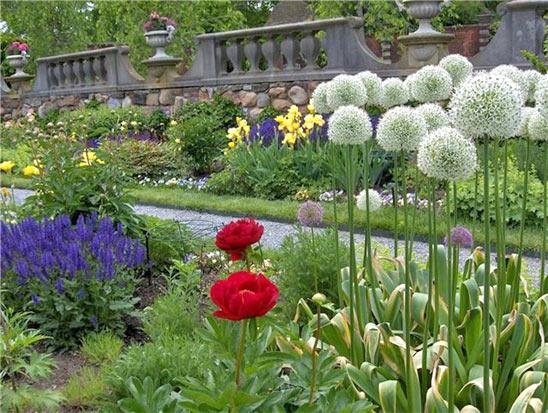

At first glance, it is not always possible to determine that these are the closest relatives of common onions. And when you understand this, it causes genuine surprise.
I must say that the color of the inflorescence of decorative onions is so diverse that it can be combined with almost any plants. Let's try to consider how this can be done.
The use of allium in landscape design
Different varieties of onions are used to create green compositions that adorn city streets, parks, and private plots.This plant fits perfectly into the pictures of rockeries and alpine hills, stone gardens, it can be planted as border plantings, in group flower arrangements.
When choosing varieties, the flowering period of plants is taken into account:
- early flowering;
- average flowering period;
- late flowering.
It is also important to know the height of the plants:
- tall, peduncle length from 80 cm;
- medium-sized, peduncle from 40 to 80 cm;
- undersized - up to 40 cm.
When planning the planting of ornamental onions, it should be borne in mind that the first, basal leaves of plants quickly turn yellow, naturally, the attractiveness of the plant decreases. To preserve the decorativeness of the flower bed, you should arrange other low-growing plants in such a way that they cover the leg of the allium.
As for the location of the plants themselves, the dwarf varieties of allium look more impressive in a group planting, tall ones can be planted both in groups and one at a time.
Geranium, ornamental poppy, hostu, herbaceous peony, irises, cuff can be planted as companion plants next to onions.
We offer you to watch an interesting video about the varieties and use of decorative onions:
What else do you need to know about flower care?
Once a year, mainly in spring, it is necessary to loosen the area where the bulbs are planted, to clean it of debris and mold. After the leaves have grown in the spring, the plant must be fertilized. To improve wintering, so that the plant feeds and survives, it is necessary to fertilize with special phosphorus-potassium fertilizers during the budding period. In the spring, they are fed with special mineral fertilizers. In the summer heat, the plant needs liquid fertilizers. This is all that a florist still needs to know to care for allium flowers in the garden and on his personal plot.
Is it possible to eat decorative allium bow
Even by the name of the plant, it can be assumed that it is more decorative. Leaves and bulbs are distinguished by a rather pronounced aroma and original taste. Moreover. all parts of the plant have healing properties.
Onion leaves can be added in small quantities to spring salads, but the period of edibility of the leaves is limited, it ends with the beginning of the formation of the peduncle. Leaves from a flowering plant are not recommended for food.
Bulbs are used for baking and pickling, but they should not be consumed in large quantities, one must take into account the rather high risk of developing an allergic reaction.
The beneficial properties of allium are due to the high content of vitamin C, vitamins E and D. Traditional medicine offers the use of the product as a means for the prevention of oncological diseases, fortifying and increasing immunity.
Moderate consumption of onions:
- has a beneficial effect on the vessels of the brain, relieves spasm;
- improves vision;
- heals gastrointestinal diseases;
- helps to defeat colds;
- onion juice accelerates hair growth.
But taking a large amount of the product (more than 3 g per day) can cause allergies and even poisoning.
Most attractive
Allium aflatunense onion
This onion can be seen, perhaps, in every garden, and its cutting is traditionally popular. Belongs to the group of Anzur. The peduncle is high, up to 1.5 m. The leaves are large, broadly oval, gray-green. The flowers are star-shaped, purple. The inflorescence is a very dense multi-flowered umbrella with a diameter of 7-10 cm. The bulbs are edible, they are used for pickling, baking, boiled in honey, and also as a medicine. The plant is unpretentious and very resilient.
Varieties: ‘Mother of Pearl’ - flowers are light purple; ‘Lucy Ball’ - dark purple-purple; ‘Gladiator’ - pink ‑ purple; ‘Samson’ - the first domestic variety, purple flowers.
On a note. The bulbs should be planted in the middle or in the background of the flower garden to hide the yellow-tipped onion leaves under the decorative foliage of other plants.
In design... Good in small independent groups on the lawn, against the background of trees and bushes. Great plant for high curbs. A frequent component of mixed monochrome groups of purple bows of varying heights. It is used in mixborders, in sparse plantings among decorative-leaved perennials.
Blue onion A. caeruleum syn. A. azureum
The species got its name for its bright blue, very beautiful inflorescences. Pedicels and filaments are also blue. Peduncle up to 80 cm high. The leaves are triangular, grooved, up to 1 cm wide, gray-green in color, with a rough surface. The flowers are small, bell-shaped, bright blue.
The inflorescence is a dense spherical umbel with a diameter of about 5 cm. Often, in the inflorescence, along with flowers, numerous small, dark purple bulbs are formed.
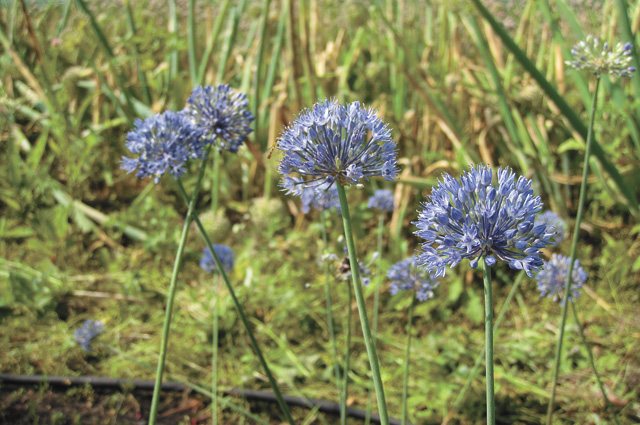

Blue onion. Photo: Valentina Kokoreva
There is a "viviparous" variety of blue onions - A. caeruleum var. bulbilliferum. It is characterized by the formation of a large number of bulbs and single flowers, in which no seeds are formed.
A place for planting should be chosen light, dry enough, since plants of this species do not tolerate waterlogging well.
On a note... The young leaves of this onion are used as mild salad greens, and the onions are pickled.
In design... A group of blue onion plants on the lawn will undoubtedly become the pride of the gardener. A flower garden in blue tones made of blue onions, forget-me-nots, brunner, delphiniums and other flowers will give the corner of the garden extraordinary freshness. This bow is also appropriate in a rocky garden. Dried flowers of rare color.
Zebdan onion A. zebdanense
The delicate snow-white inflorescences of this onion are magnificent against the background of emerald leaves. Peduncles are thin, flexible, up to 60 cm high. In loose inflorescences about 3 cm in diameter, up to 15 large white "bells" with a faint pleasant smell.
Grows well in the light shade of trees.
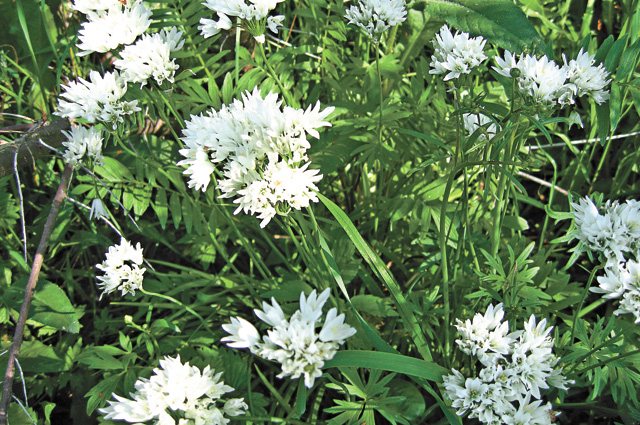

Zebdansky onion Photo: Valentina Kokoreva
On a note... If this unpretentious plant is provided with good care, then it will generously respond with abundant flowering.
In design... Good in group planting and in the curb.
Karatavian onion A. karataviense
This plant is so unusual that you can hardly recognize the onion in it. The peduncle is deeply buried in the ground, the height of the aboveground part is from 15 to 25 cm. The leaves are flat, oval, up to 15 cm wide, bluish-green, with a metallic sheen, with a thin purple strip along the smooth edge. They extend widely to the sides of the base or almost lie on the ground. The flowers are stellate, grayish-pink, with a darker central vein. The inflorescence is a dense spherical umbrella with a diameter of about 10 cm. After flowering, quite decorative pinkish fruit-boxes are formed.
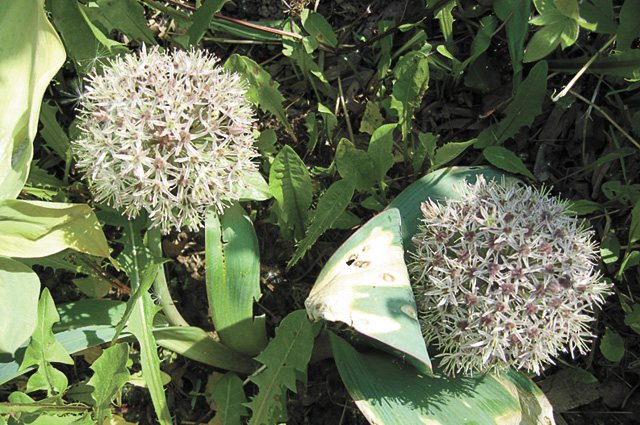

Karatav bow. Photo: Valentina Kokoreva
‘Ivory Queen’ has creamy white flowers, very short stems (15–20 cm) and late flowering.
Planting bulbs must be carried out in well-drained, warm, loose fertile soil.
On a note... This species is propagated mainly by sowing seeds, since the bulb divides only 6–8 years after planting.
In design. This original, exquisite plant is undoubtedly a find for planting in a variety of rocky gardens, in a gravel bed near a reservoir. It can also be planted along the front edge of the mixborder, since the leaves do not lose their attractiveness for a long time. Looks good surrounded by low-growing ground cover plants.
Christophe's onion A. christophii, or white-haired A. albopilosum
This bow attracts the eye with the metallic sheen of large inflorescences. The peduncle is about 40 cm high, about 1.5 cm in diameter, buried in the soil at the base. Leaves are flat, up to 3 cm wide, gray-green in color, pubescent at the edges. The flowers are star-shaped, from light to purple-violet, with tint. The inflorescence is a very large spherical shiny umbrella up to 20 cm in diameter.This plant was previously even called the star of Persia, now florists jokingly call it a porcupine.
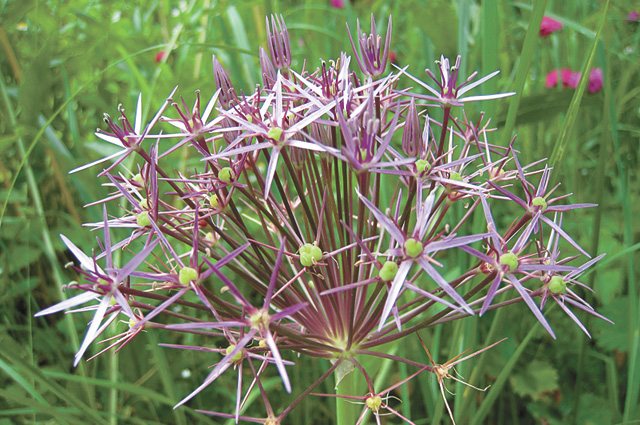

Christophe's bow. Photo: Valentina Kokoreva
On a note... After flowering, the inflorescences become tough and do not lose their decorative effect, so the peduncles can not be removed.
In design... Looks elegant in gravel and rocky gardens, good in combination with decorative grasses and ground cover plants.
Round-headed onion A. sphaerocephalum
The thin flower arrows of this bow, crowned with oval maroon inflorescences, resemble drumsticks, for which it received the common name Drumsticks in Germany.
Peduncle about 60 cm high. Fisty leaves, 3-5 cm wide. Flowers are small, bell-shaped, brown-red. Umbel is oblong-ovate, very dense, up to 4 cm in diameter. As the flowers bloom, the color of the umbrella successively from base to apex changes from green to rich brown-red.
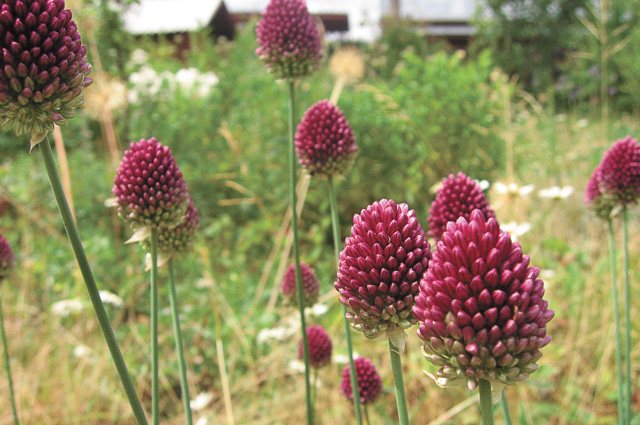

Round-headed onion. Photo: Valentina Kokoreva
The plant is unpretentious, drought-resistant, grows equally well in a sunny place and in partial shade.
On a note... The plant quickly settles outside the territory allotted to it in the garden, so the faded inflorescences need to be cut off in time.
In design... This onion with a bright color of inflorescences is good in group plantings of different sizes on lawns and lawns. Its arrays are especially effective. They are used in mixborders and sparse plantings together with a cuff, ornamental cereals. Compact umbrellas look decorative not only during the entire flowering period, but also during seed ripening.
Moth onion, or golden A. moly syn. A. aureum
In the literature, the name of this species is often mistakenly used as the Mola onion. An old legend says that a bunch of moth onion inflorescences helped Odysseus leave the possession of Circe unharmed. Since then, in southern European folklore, this plant, which protects against demons and evil spirits, is considered a symbol of good luck.
Peduncle 15–25 cm high. Leaves are flat, lanceolate, gray-green in color. The flowers are large, golden, shiny; anthers are orange. The inflorescence is a hemispherical loose umbrella, which has up to 40 flowers.
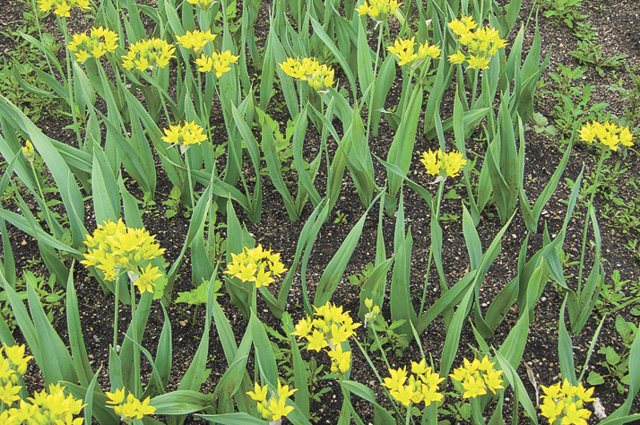

Moth onion, or golden. Photo: Valentina Kokoreva
The 'Jeannine' garden form has an earlier flowering, and two flower arrows grow from one bulb, which makes the flowering richer and more luxuriant. The flowers are pale yellow, golden. Prefers a sunny place, but they also put up with partial shade.
On a note... So that the planting of this onion does not lose its decorative effect, the bulbs should be dug and sorted at least once every 5 years. Large bulbs are planted in flower beds, and small ones for growing.
In design. This spectacular onion, when planted in a dense group, brings a bright accent to the garden. A welcome component of any rocky garden. He is willingly planted in the foreground of the mixborder. It goes well with muscari, low ornamental grasses, but especially with Ostrovsky's ‘Agalik’s Giant’ onions, which bloom almost simultaneously with purple flowers.
Bowed onion A. cernuum
This native of the dry forests and prairies of North America is very interesting for rock gardens and rockeries. Young leaves are edible, have a characteristic onion smell, but are less tasty than salad onions. They are flat, up to 30 cm long, 5–7 mm wide, collected in a fan-shaped root rosette.
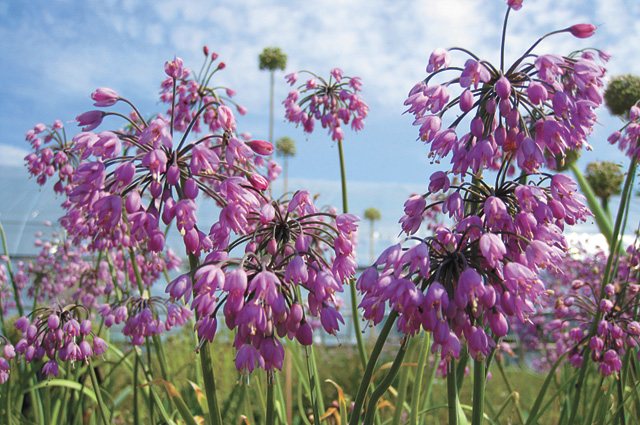

Bow bow. Photo: Valentina Kokoreva
Peduncle up to 50 cm long, drooping, ends with a loose inflorescence. The flowers are dark pink, with yellow anthers on long filaments. Seeds in the inflorescence are tied in less than a third of the flowers. After the flowers turn into fruits, the pedicels are straightened so that the photosynthesizing green bolls are facing the sun. The seeds are small. When grown from seed, the plants bloom in the second year.
The ‘Major’ variety is distinguished by larger than the natural species, inflorescences of pale pink flowers.
On a note... The seed productivity of this onion in the temperate zone is low, therefore in ornamental gardening it is propagated mainly by dividing the bush.
In design... They are planted on alpine hills, in rocky gardens, in a decorative garden.
Stalked onion A. stipitatum
Anzur onion is very popular and has long been used in culture. Peduncles are high, 1–1.3 m. The leaves are green, belt-like, 3–5 cm wide. The flowers are star-shaped, lilac-violet. Umbrella is multi-flowered, spherical, up to 8 cm in diameter.
The varieties of hybrid origin ‘Mont Blanc’, ‘Mount Everest’ and the garden form ‘Album’ have white flowers. Their beautifully shaped leaves remain green for a long time. The 'Pink Globe' variety has a characteristic pinkish color of flowers.
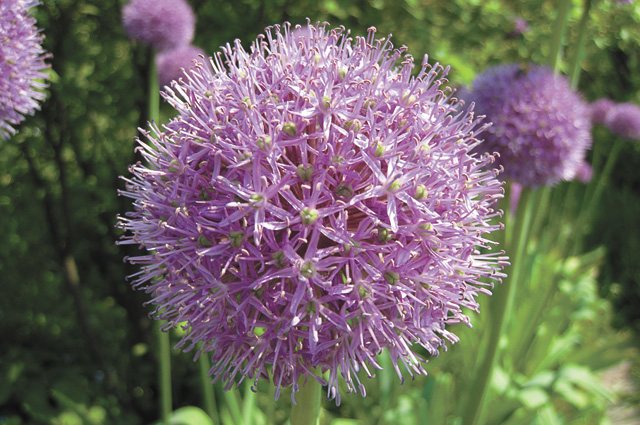

Stalked onion Photo: Valentina Kokoreva
Poorly tolerates waterlogged soils, good drainage is necessary.
On a note... The bulbs should be dug out only after the leaves are completely dry.
In design... It is used in group plantings, massifs of landscaped gardens, in plantings of decorative leafy plants. Magnificent dried flowers.
Tuberous onion A. tuberosum
Tuberous onion gives two waves of growth of flowering shoots and flowering. The height of the arrows of the first wave is about 50 cm. During their mass flowering, the active growth of peduncles of the second wave begins, which already grow up to 70 cm and during the budding period practically do not shade the inflorescences of the first tier. This is followed by a second wave of flowering. Both of these flowering periods partially coincide, including due to the different ages of flowers in the inflorescences, and it is at this time that the plants are most decorative. During the period of mass flowering, groups of tuberous onion plants turn into rare white cumulus clouds against a background of dark green leaves that do not turn yellow for a long time.
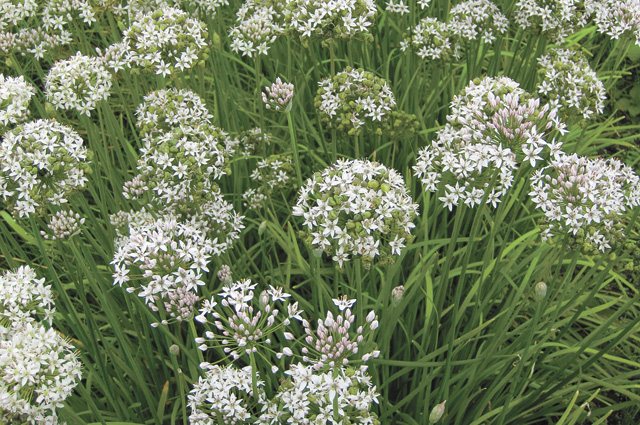

Tuberous onion. Photo: Valentina Kokoreva
On a note... An excellent salad plant.
In design... Perennial mixborder element, garden decoration in autumn.
Pretty onion A. pulchellum
The inflorescences of this onion resemble miniature fountains with falling streams. Peduncle up to 50 cm high. Leaves are narrow, semi-cylindrical, furrowed, rough. The flowers are small, bell-shaped, drooping, on long thin pedicels, grayish-pink, matte. Anthers are light purple. The inflorescence is a loose graceful umbrella. The pistil and stamens protrude strongly from the perianth. Blooms in July for about two weeks. The garden form ‘Album’ has a snow-white color of flowers.
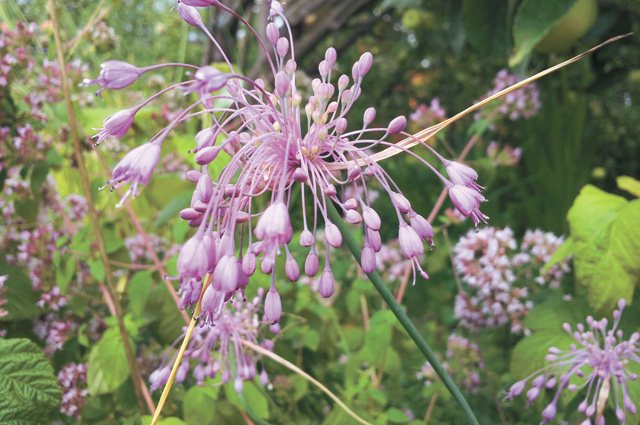

The onion is pretty. Photo: Valentina Kokoreva
On a note... The plant is thermophilic and needs light shelter for the winter.
In design... This graceful bow is planted in rocky gardens, group plantings and curbs.
Breeding methods
There are two ways to increase the number of plants: by sowing seeds or vegetatively.
Seeds can be sown in spring or autumn, picking is done directly in the beds, it is recommended to choose areas well-lit by the sun.
Some types of onions, such as giant and stemmed onions, sprout only when sowing in winter.
The flowering of varieties such as anzura and wild garlic will begin only at 4-7 years of plant life, by this age the bulbs will gain weight, which is necessary for the reproductive process.
The vegetative method involves planting babies that are formed on the mother's bulb.
For the reproduction of rhizome species, the division of the bushes is used.
Exquisite jewelry
Favorite size. Among the bows there are both real giants and dwarfs. In the former, the arrows reach up to 1.5 m or even more, and in the latter, from 5 to 20 cm. Moreover, the botanical names - high onion, high onion, large onion, giant onion or low onion - often speak for themselves.
Favorite color. The color of flowers can be white, greenish, yellow, pink, red, purple, lilac, blue, blue, violet, almost black, as well as transitional tones and various shades. A two-tone color is less common.Many species have natural or artificially produced albino white-flowered forms.
Originality. The individual flowers of the bows are small and sometimes inconspicuous, but the umbrella inflorescences, in which there are up to a thousand flowers, look impressive on the tops of slender peduncles. Inflorescences of different types are sometimes similar to fluffy balls, then to fountains with falling streams, then to tumbleweeds.
Diseases and the fight against them
Diseases and pests rarely have a negative impact on the condition of bulbous plantations. The pungent smell scares away harmful insects and rodents. Of the diseases, the most dangerous is rot, from which the underground part of the plant can suffer with excessive soil moisture.
Failure to follow care recommendations, in particular, excessive soil moisture, can lead to damage by downy mildew or various types of rot. An onion fly or root mite can also harm the plant.
Preventive measures include:
- warming the bulbs before planting for 10 hours at a temperature within +40 C;
- treatment of affected plants with 2% chlorophos solution;
- peat mulching;
- pollination of the plant with wood ash or tobacco dust.
Onion varieties of hybrid origin
There are dozens of varieties of hybrid origin on the flower market, the parental species of which are often unknown or controversial. The following are popular: 'Ambassador', 'Beau Regard', 'Firmament', 'Gladiator', 'Globemaster', 'Globus',' His Exсellency ',' Lucy Ball ',' Mars', 'Pinball Wizard', 'Purple King ',' Rien Poortvliet ',' Round and Purple ',' Violet Beauty ',' White Giant 'and others. A very original novelty of recent years - a cultivar under the playful name ‘Hair’, which means “hair,” in Russian it is called a hairy. Thin long green leaves of airy bulbs ("hair") make the inflorescence look like a disheveled head.
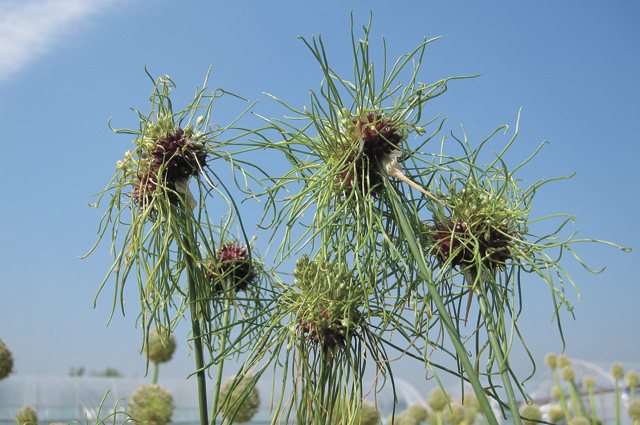

"Hairy", or ‘Hair’. Photo: Valentina Kokoreva
Site selection and preparation
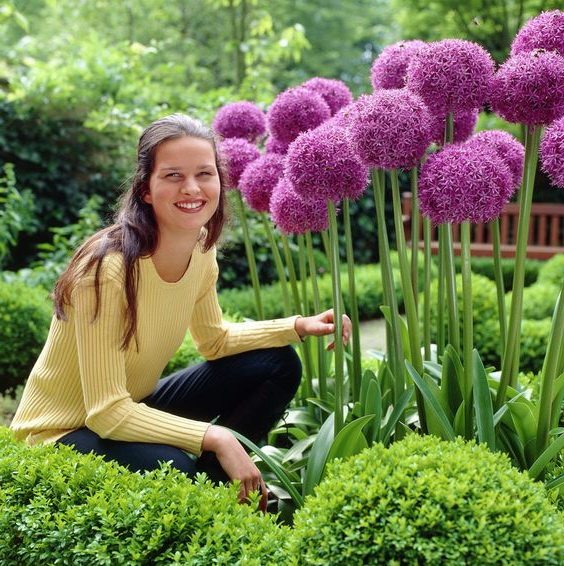

Allium giant planting and care photos
Allium has the most beautiful flowering in sunny, well-lit areas., on the southern slopes. Even a slight partial shade can reduce the color intensity of flowers and leaves. Tall varieties must be protected from the wind so that they do not break in gusts - it is worth choosing a protected place in advance.
It is preferable for planting an area with fertile soils., additionally fed with a complex mineral fertilizer, with neutral acidity (pH about 7.0). In more acidic soil, dolomite flour or lime is additionally required.
Soil water permeability is an important condition when choosing a landing site... Allium bulbs are still able to withstand short-term waterlogging of the soil, but with poor drainage they rot. Although decorative onions are good for what, among the variety of varieties, an exception to the rule can be found: the varieties Farrera and Allium Moli are most tolerant of moisture and cold.
Allium Ivory Queen
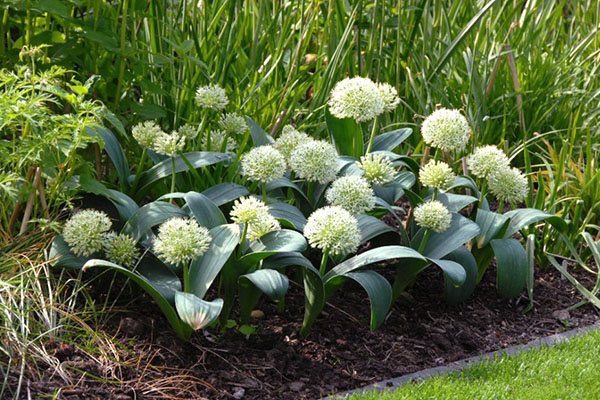

Allium Ivory Queen is planted in the gardens of Russia quite often, which is explained by their unpretentiousness in care, as well as with a small growth - the shoots reach a maximum of 35 cm.At the same time, the flower pleases with large inflorescences - up to 12 cm.The color of the buds is white, milky, ivory.
The green-blue hue of the leaves and the endless aroma give the plant a special charm. Allium begins to bloom in mid-July, the buds can be seen within a month.
Growing alissum from seeds
Sowing
It is possible to grow alissum from seeds in a seedless and seedling way. If a seedless growing method was chosen, then sowing seeds in open soil should be done in the first days of May. They are buried in the soil only 15 mm. After the seedlings appear as a solid carpet, they will need to be thinned out. If sowing was carried out in spring, then flowering will be belated.Sowing can be done before winter, in the cold season, the seeds will be able to undergo natural stratification, and then in the spring, friendly shoots will appear, while the senses will be relatively strong and their flowering will begin in a timely manner.
Seedling care
However, most gardeners prefer to grow alissum through seedlings, because this method is distinguished by its reliability. Sowing seeds for seedlings is carried out in March or April. The boxes should be filled with a nutritious light substrate, which contains a little lime (pH 5.5-6.2). The seeds are evenly distributed over the surface of the substrate, not very densely, then they are slightly pressed into the surface or sprinkled with a thin layer of the substrate. The containers must be rearranged in a well-lit place, having previously covered them with film or glass. The optimum temperature should be between 10 and 15 degrees. Crops should be moderately moistened and ventilated regularly. If everything is done correctly, then the first seedlings will appear after 7 days or earlier.
Immediately after the seedlings begin to form the first true leaf plate, they should be fed with complex fertilizer. It will be possible to cut the seedlings into individual cups only after the plants have formed 2 or 3 true leaf plates. However, if the seedlings grow very quickly, then you do not need to dive them, when the time comes, they are immediately planted in open soil.
Diseases and pests
Onions are affected by the following diseases and insects:
| Disease / Pest | Damage | Control measures |
| Peronosporosis | Blurry greenish spots appear on the foliage. A gray-violet mycelium is formed in the form of a plaque. Greens turn yellow, become brown, dries up. | The diseased foliage is collected. The bushes are processed with commercially available means (Bordeaux mixture, copper oxychloride, kartotsid, ridomil). |
| Rust | In spring, orange plaques are observed on the greenery. After a while, red-yellow spores form. The foliage dries up. | Affected leaves are destroyed. Onions are sprayed with preparations containing copper (copper oxychloride, Bordeaux mixture). |
| Smut | Dark gray stripes appear. The leaf plates and pedicels are bent. | |
| Heterosporia | The foliage turns yellow, covered with a brown bloom. The greenery dries up, the yield deteriorates. | |
| Cercosporosis | Damage appears in early summer. Clear gray spots with a thin yellowish border are formed on the leaves and stems. The affected areas do not rot. Greens turn yellow and dry out. | |
| Golden bronze | It is a large green insect with a bronze, golden tint. Reaches 14-20 mm. If you look at the photo, you can see transverse white lines on the wings. The larvae are thick, snow-white, up to 60 mm in length. Pupa yellowish, formed in an earthen cocoon. Pests fly from May to late summer. | Beetles and larvae are collected. |
Where to buy allium seeds
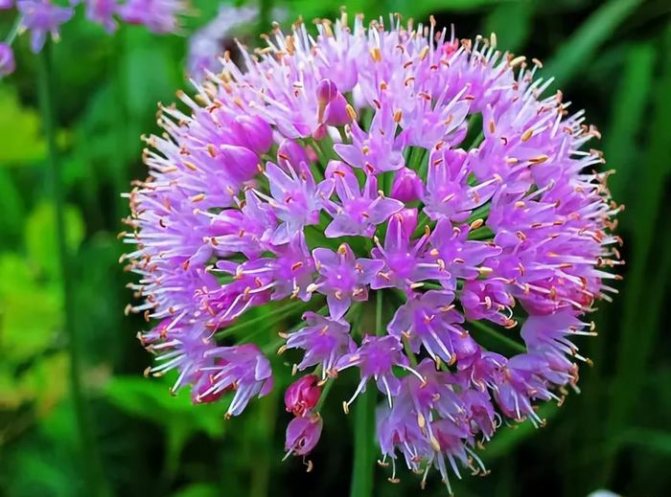

The Scientific and Production Association "Sady Rossii" has been introducing the latest achievements in the selection of vegetable, fruit, berry and ornamental crops into the wide practice of amateur gardening for 30 years. In the work of the association, the most modern technologies are used, a unique laboratory for microclonal reproduction of plants has been created. The main tasks of NPO Sady Rossii is to provide gardeners with high-quality planting material for popular varieties of various garden plants and novelties of world selection. Delivery of planting material (seeds, onions, seedlings) is carried out by Russian post. We are waiting for you for shopping: NGO "Gardens of Russia"
[/ td]
How to propagate and when to plant allium
Wild onions reproduce in several ways.
Vegetative with the help of children
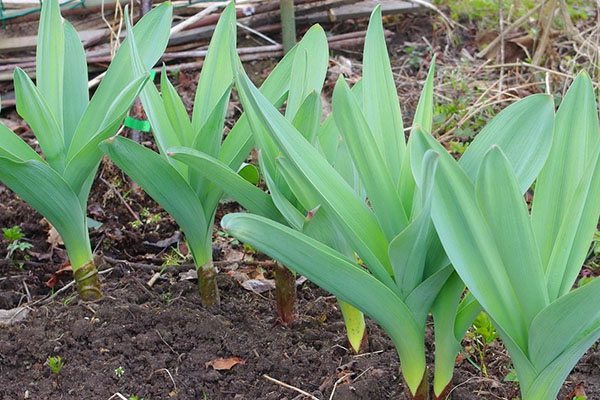

Three years after planting the seeds, the bulb produces babies, which must be planted very carefully in the fall so that the roots and stems are not damaged. The excavated material is stored at a temperature of 18-20 ° C in a dry and ventilated room.
Planting early flowering allium in the ground is recommended in autumn, and late flowering in spring.
The bulbs are planted at a distance of half a meter from each other to a depth of three bulbs, after watering the hole, and after planting, mulching with humus or peat. Next time they can be transplanted in 4-5 years.
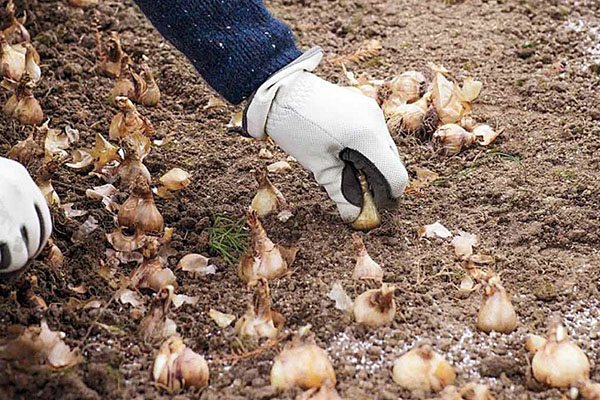

Vegetative with bulb
Onion buds act as bulbs, which must be pretreated with a growth stimulant and rooted. This method of reproduction fully conveys all the characteristics of the parent variety to the future plant.
Seed method
Treated seeds are usually sown in the fall or spring directly into the ground. Some varieties require prior stratification. This method is very long, since the plant will open its buds only after three years. Therefore, it is not popular.
Description
Allium is a beautiful ornamental perennial plant from the onion subfamily. The peculiarity of the herbaceous culture in size, stem height and external beauty. Designers value allium for the inflorescences that decorate the garden plot, which can be combined with a large number of flowers and shrubs.
The underground part of the culture is the bulb, the above-ground part is the leaves and flowers. Bulbs are ovoid, covered with light husks. The inflorescences are made up of many small flowers that form a single whole.
Shades of flowers are different: from white, yellow to pink, purple, violet. Leaves are concentrated at the root part, often thick, flat or puffy, saturated green. The uniqueness of Allium is that it serves not only to decorate the site, but is also used to prepare salads and main courses.


Alyssum in pots
In the middle zone, where many annuals do not give such lush flowering as in the south, simply because there is little heat and the growing season is not long enough (the plants do not have time to grow, as they are "caught" by the night cold), alissum is often grown in hanging pots ...
In hanging pots, plants especially need attention: watering with settled warm water, feeding with liquid flower fertilizer.
For abundant flowering - regular removal of faded inflorescences and pruning too elongated "knocked out" shoots that have lost their decorative effect.
In this case, you can more carefully approach the care of plants and place them in sunny places, achieving maximum flowering. In addition, in hanging baskets, plants show their "temper" - heavy inflorescences go down, and nothing prevents them from developing shoots in length.
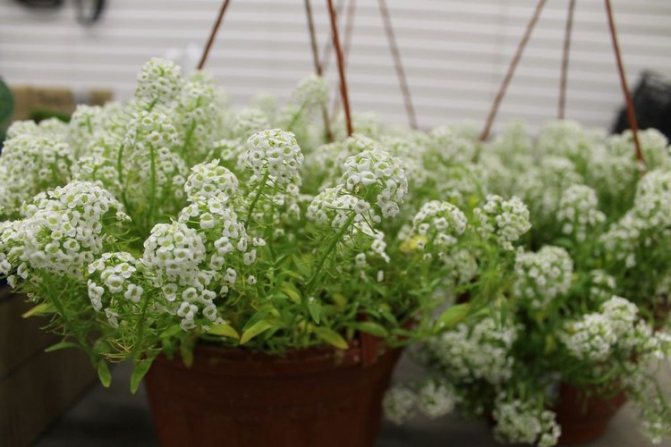

Pruning alyssum
In order for the alissum to develop correctly and bloom magnificently, it must be cut off in a timely manner and correctly. In spring, it is necessary to cut off all dried foliage from perennials, peduncles left over from last year, as well as weak and diseased stems. When the summer flowering is over, it is necessary to repeat the pruning procedure, and then shorten all the stems by 50–80 mm, this will provoke repeated flowering. In addition, the bushes after pruning look more compact and well-groomed.
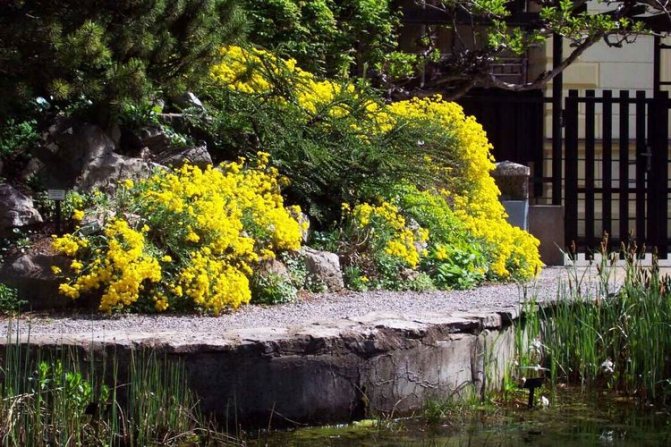

Alyssum flower photo care
Even inexperienced growers can handle an unpretentious flower. The optimum soil is light, fertile. You can use slightly alkaline mixtures. Drainage is imperative to avoid excessive moisture. It is also important not to overfeed the flower. With too intense nutrition, foliage grows well, but alyssum almost does not bloom.
To prolong flowering, you need sun and air. Well ventilated areas are ideal. Aging perennial plants should be gradually thinned towards the young and strong.
For regular maintenance, it is enough to loosen and weed the soil. Top dressing is introduced before and after flowering.
For 10 liters of water add 1 tbsp. l. urea. The resulting solution is poured over the plantings. Before flowering alissum, a complex fertilizer is applied.
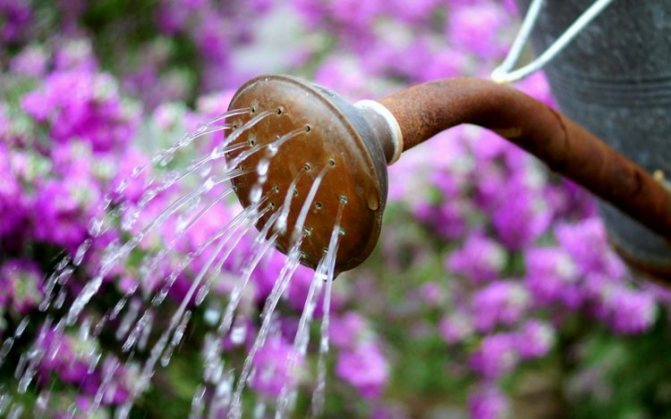

Up to 4 dressings are allowed per season. An interval of 2 weeks is made between plant treatments.


